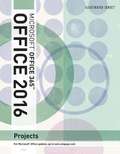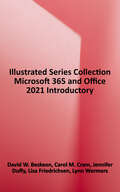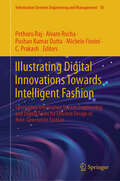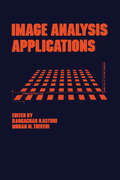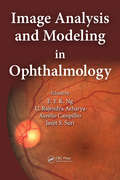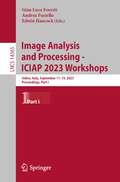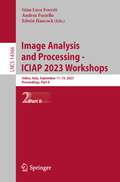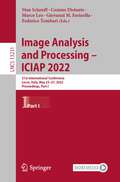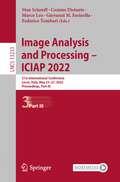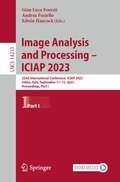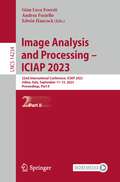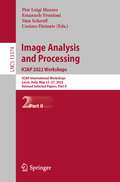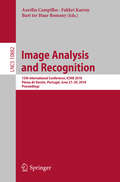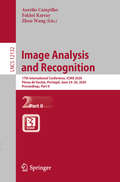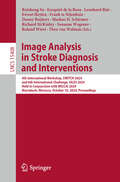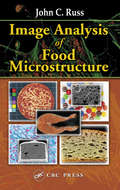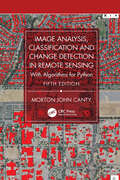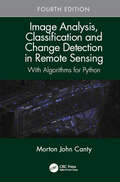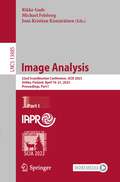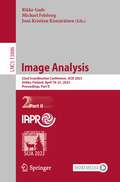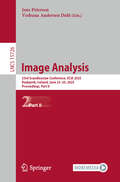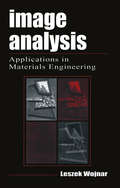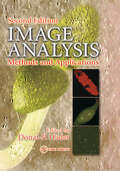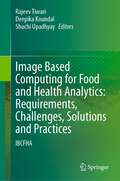- Table View
- List View
Illustrated Microsoft® Office 365™ & Office 2016 Projects
by Carol M. CramThis highly visual book offers a wide array of interesting and challenging projects designed to apply the skills learned in any Office 2016 book. The Illustrated Projects book is for people who want more opportunities to practice important software skills.
Illustrated Series Collection, Microsoft 365 & Office 2021 Introductory (MindTap Course List)
by Jennifer Duffy Lisa Friedrichsen Lynn Wermers Carol M. Cram David W. BeskeenIncluding the latest Microsoft 365 features and enhanced support for Mac users, Cengage's Illustrated Series Collection, Microsoft 365 & Office 2021 Introductory, 1st edition, helps you quickly master the nuances of Microsoft Office. Its concise, student-friendly approach uses a proven two-page layout that allows you to work through an entire task without turning the page. Each module begins with a brief overview of the principles covered while large, full-color screen images illustrate what you see on your computer. Module Learning Objectives are mapped to Microsoft Office Specialist (MOS) certification objectives, and module scenarios are based on Burning Glass market insights data -- helping you sharpen the critical skills you need for real-world success. In addition, MindTap and SAM (Skills Assessment Manager) online resources help maximize your study time -- and results.
Illustrating Digital Innovations Towards Intelligent Fashion: Leveraging Information System Engineering and Digital Twins for Efficient Design of Next-Generation Fashion (Information Systems Engineering and Management #18)
by Pethuru Raj Alvaro Rocha Pushan Kumar Dutta C. Prakash Michele FioriniThis book presents the mass manufacturing and manifestation of smart clothes that have decisively kick-started the fashion industry With the flourishing of edge and digitization technologies, every tangible thing in and around us is all set to become digitized. The arrival of advanced communication and digitalization technologies has made any digitized entity to be connected and cognitive. With this transition, the textile industry is strategizing to leverage the improvisations being accomplished in the digital era to design, develop, and deliver digitally enabled dresses and clothes. Smart attires are fabrics bedded with ultrathin, flexible and transparent detectors, selectors, electronics, and connectivity, and there are nano-creators to power smart dresses. The mass manufacturing and manifestation of smart clothes have decisively kick-started the fashion industry. The readers will come across the implementation technologies and the research results of virtual try-on, body size and pose estimation, diffusion-based fashion synthesis, etc.
Image Analysis Applications
by Rangachar Kasturi, Mohan M. TrivediThis book presents a wide spectrum of applications where image analysis has been successfully employed, providing the reader with an insight into the merits or demerits of a particular technique. It deals with the domain of graphics recognition, document analysis, and map data interpretation.
Image Analysis and Modeling in Ophthalmology
by Jasjit S. Suri U. Rajendra Acharya Aurélio Campilho E. Y. K. NgDigital fundus images can effectively diagnose glaucoma and diabetes retinopathy, while infrared imaging can show changes in the vascular tissues. Likening the eye to the conventional camera, Image Analysis and Modeling in Ophthalmology explores the application of advanced image processing in ocular imaging. This book considers how images can be us
Image Analysis and Processing - ICIAP 2023 Workshops: Udine, Italy, September 11–15, 2023, Proceedings, Part I (Lecture Notes in Computer Science #14365)
by Edwin Hancock Andrea Fusiello Gian Luca ForestiThe two-volume set LNCS 14365 and 14366 constitutes the papers of workshops hosted by the 22nd International Conference on Image Analysis and Processing, ICIAP 2023, held in Udine, Italy, in September 2023.In total, 72 workshop papers and 10 industrial poster session papers have been accepted for publication. Part I of the set, volume 14365, contains 10 papers from the industrial poster session, and 31 papers from the following workshops:– Advances in Gaze Analysis, Visual attention and Eye-gaze modelling (AGAVE)– Beyond Vision: Physics meets AI (BVPAI)– Automatic Affect Analysis and Synthesis (3AS)– International Contest on Fire Detection (ONFIRE)– Recent Advances in Digital Security: Biometrics and Forensics (BioFor)– Computer Vision for Environment Monitoring and Preservation (CVEMP)– Generation of Human Face and Body Behavior (GHB)
Image Analysis and Processing - ICIAP 2023 Workshops: Udine, Italy, September 11–15, 2023, Proceedings, Part II (Lecture Notes in Computer Science #14366)
by Edwin Hancock Andrea Fusiello Gian Luca ForestiThe two-volume set LNCS 14365 and 14366 constitutes the papers of workshops hosted by the 22nd International Conference on Image Analysis and Processing, ICIAP 2023, held in Udine, Italy, in September 2023.In total, 72 workshop papers and 10 industrial poster session papers have been accepted for publication. Part II of the set, volume 14366, contains 41 papers from the following workshops:– Medical Imaging Hub:• Artificial Intelligence and Radiomics in Computer-Aided Diagnosis (AIR-CAD)• Multi-Modal Medical Imaging Processing (M3IP)• Federated Learning in Medical Imaging and Vision (FedMed)– Digital Humanities Hub:• Artificial Intelligence for Digital Humanities (AI4DH)• Fine Art Pattern Extraction and Recognition (FAPER)• Pattern Recognition for Cultural Heritage (PatReCH)• Visual Processing of Digital Manuscripts: Workflows, Pipelines, BestPractices (ViDiScript)
Image Analysis and Processing – ICIAP 2022: 21st International Conference, Lecce, Italy, May 23–27, 2022, Proceedings, Part I (Lecture Notes in Computer Science #13231)
by Cosimo Distante Marco Leo Stan Sclaroff Giovanni M. Farinella Federico TombariThe proceedings set LNCS 13231, 13232, and 13233 constitutes the refereed proceedings of the 21st International Conference on Image Analysis and Processing, ICIAP 2022, which was held during May 23-27, 2022, in Lecce, Italy,The 168 papers included in the proceedings were carefully reviewed and selected from 307 submissions. They deal with video analysis and understanding; pattern recognition and machine learning; deep learning; multi-view geometry and 3D computer vision; image analysis, detection and recognition; multimedia; biomedical and assistive technology; digital forensics and biometrics; image processing for cultural heritage; robot vision; etc.
Image Analysis and Processing – ICIAP 2022: 21st International Conference, Lecce, Italy, May 23–27, 2022, Proceedings, Part III (Lecture Notes in Computer Science #13233)
by Cosimo Distante Marco Leo Stan Sclaroff Giovanni M. Farinella Federico TombariThe proceedings set LNCS 13231, 13232, and 13233 constitutes the refereed proceedings of the 21st International Conference on Image Analysis and Processing, ICIAP 2022, which was held during May 23-27, 2022, in Lecce, Italy,The 168 papers included in the proceedings were carefully reviewed and selected from 307 submissions. They deal with video analysis and understanding; pattern recognition and machine learning; deep learning; multi-view geometry and 3D computer vision; image analysis, detection and recognition; multimedia; biomedical and assistive technology; digital forensics and biometrics; image processing for cultural heritage; robot vision; etc.
Image Analysis and Processing – ICIAP 2023: 22nd International Conference, ICIAP 2023, Udine, Italy, September 11–15, 2023, Proceedings, Part I (Lecture Notes in Computer Science #14233)
by Edwin Hancock Andrea Fusiello Gian Luca ForestiThis two-volume set LNCS 14233-14234 constitutes the refereed proceedings of the 22nd International Conference on Image Analysis and Processing, ICIAP 2023, held in Udine, Italy, during September 11–15, 2023.The 85 full papers presented together with 7 short papers were carefully reviewed and selected from 144 submissions. The conference focuses on video analysis and understanding; pattern recognition and machine learning; deep learning; multi-view geometry and 3D computer vision; image analysis, detection and recognition; multimedia; biomedical and assistive technology; digital forensics and biometrics; image processing for cultural heritage; and robot vision.
Image Analysis and Processing – ICIAP 2023: 22nd International Conference, ICIAP 2023, Udine, Italy, September 11–15, 2023, Proceedings, Part II (Lecture Notes in Computer Science #14234)
by Edwin Hancock Andrea Fusiello Gian Luca ForestiThis two-volume set LNCS 14233-14234 constitutes the refereed proceedings of the 22nd International Conference on Image Analysis and Processing, ICIAP 2023, held in Udine, Italy, during September 11–15, 2023.The 85 full papers presented together with 7 short papers were carefully reviewed and selected from 144 submissions. The conference focuses on video analysis and understanding; pattern recognition and machine learning; deep learning; multi-view geometry and 3D computer vision; image analysis, detection and recognition; multimedia; biomedical and assistive technology; digital forensics and biometrics; image processing for cultural heritage; and robot vision.
Image Analysis and Processing. ICIAP 2022 Workshops: ICIAP International Workshops, Lecce, Italy, May 23–27, 2022, Revised Selected Papers, Part II (Lecture Notes in Computer Science #13374)
by Cosimo Distante Pier Luigi Mazzeo Stan Sclaroff Emanuele FrontoniThe two-volume set LNCS 13373 and 13374 constitutes the papers of several workshops which were held in conjunction with the 21st International Conference on Image Analysis and Processing, ICIAP 2022, held in Lecce, Italy, in May 2022.The 96 revised full papers presented in the proceedings set were carefully reviewed and selected from 157 submissions.ICIAP 2022 presents the following Sixteen workshops:Volume I:GoodBrother workshop on visual intelligence for active and assisted livingParts can worth like the Whole - PART 2022Workshop on Fine Art Pattern Extraction and Recognition - FAPERWorkshop on Intelligent Systems in Human and Artificial Perception - ISHAPE 2022Artificial Intelligence and Radiomics in Computer-Aided Diagnosis - AIRCADDeep-Learning and High Performance Computing to Boost Biomedical Applications - DeepHealthVolume II: Human Behaviour Analysis for Smart City Environment Safety - HBAxSCESBinary is the new Black (and White): Recent Advances on Binary Image ProcessingArtificial Intelligence for preterm infants’ healthCare - AI-careTowards a Complete Analysis of People: From Face and Body to Clothes - T-CAPArtificial Intelligence for Digital Humanities - AI4DHMedical Transformers - MEDXFLearning in Precision Livestock Farming - LPLFWorkshop on Small-Drone Surveillance, Detection and Counteraction Techniques - WOSDETCMedical Imaging Analysis For Covid-19 - MIACOVID 2022Novel Benchmarks and Approaches for Real-World Continual Learning - CL4REAL
Image Analysis and Recognition: 15th International Conference, ICIAR 2018, Póvoa de Varzim, Portugal, June 27–29, 2018, Proceedings (Lecture Notes in Computer Science #10882)
by Aurélio Campilho Fakhri Karray Bart ter Haar RomenyThis book constitutes the thoroughly refereed proceedings of the 15th International Conference on Image Analysis and Recognition, ICIAR 2018, held in Póvoa de Varzim, Portugal, in June 2018.The 91 full papers presented together with 15 short papers were carefully reviewed and selected from 179 submissions. The papers are organized in the following topical sections: Enhancement, Restoration and Reconstruction, Image Segmentation, Detection, Classication and Recognition, Indexing and Retrieval, Computer Vision, Activity Recognition, Traffic and Surveillance, Applications, Biomedical Image Analysis, Diagnosis and Screening of Ophthalmic Diseases, and Challenge on Breast Cancer Histology Images.
Image Analysis and Recognition: 17th International Conference, ICIAR 2020, Póvoa de Varzim, Portugal, June 24–26, 2020, Proceedings, Part II (Lecture Notes in Computer Science #12132)
by Zhou Wang Aurélio Campilho Fakhri KarrayThis two-volume set LNCS 12131 and LNCS 12132 constitutes the refereed proceedings of the 17th International Conference on Image Analysis and Recognition, ICIAR 2020, held in Póvoa de Varzim, Portugal, in June 2020.The 54 full papers presented together with 15 short papers were carefully reviewed and selected from 123 submissions. The papers are organized in the following topical sections: image processing and analysis; video analysis; computer vision; 3D computer vision; machine learning; medical image and analysis; analysis of histopathology images; diagnosis and screening of ophthalmic diseases; and grand challenge on automatic lung cancer patient management.Due to the corona pandemic, ICIAR 2020 was held virtually only.
Image Analysis in Stroke Diagnosis and Interventions: 4th International Workshop, SWITCH 2024, and 6th International Challenge, ISLES 2024, Held in Conjunction with MICCAI 2024, Marrakesh, Morocco, October 10, 2024, Proceedings (Lecture Notes in Computer Science #15408)
by Theo van Walsum Roland Wiest Markus D. Schirmer Ruisheng Su Ezequiel de la Rosa Leonhard Rist Ewout Heylen Frank Te Nijenhuis Danny Ruijters Richard McKinley Susanne WegenerThis book constitutes the refereed proceedings of the 4th International MICCAI Stroke Workshop on Imaging and Treatment Challenges, SWITCH 2024, as well as the Ischemic Stroke Lesion Segmentation Challenge, ISLES 2024, held in conjunction with MICCAI 2024, in Marrakesh, Morocco, on October 10, 2024. The 12 revised full papers presented in this volume were selected form 16 submissions. The papers describe research advancements in image analysis for the diagnosis and intervention of ischemic and haemorrhagic stroke and present the latest developments in segmentation, disease prognosis, stroke diagnosis and treatment, and other clinically relevant applications.
Image Analysis of Food Microstructure
by John C. RussImage Analysis of Food Microstructure offers a condensed guide to the most common procedures and techniques by which quantitative microstructural information about food can be obtained from images. The images are selected from a broad range of food items, including macroscopic images of meat and finished products such as pizza, and the microstructu
Image Analysis, Classification and Change Detection in Remote Sensing: With Algorithms for Python
by Morton John CantyThe fifth edition of this core textbook in advanced remote sensing continues to maintain its emphasis on statistically motivated, data-driven techniques for remote sensing image analysis. The theoretical substance remains essentially the same, with new material on convolutional neural networks, transfer learning, image segmentation, random forests, and an extended implementation of sequential change detection with radar satellites. The tools which apply the algorithms to real remote sensing data are brought thoroughly up to date. As these software tools have evolved substantially with time, the fifth edition replaces the now obsolete Python 2 with Python 3 and takes advantage of the high-level packages that are based on it, such as Colab, TensorFlow/KERAS, Scikit-Learn, and the Google Earth Engine Python API.New in the Fifth Edition: Thoroughly revised to include the updates needed in all chapters because of the necessary changes to the software. Replaces Python 2 with Python 3 tools and updates all associated subroutines, Jupyter notebooks and Python scripts. Presents easy, platform-independent software installation methods with Docker containers. Each chapter concludes with exercises complementing or extending the material in the text. Utilizes freely accessible imagery via the Google Earth Engine and provides many examples of cloud programming (Google Earth Engine API). Examines deep learning examples including TensorFlow and a sound introduction to neural networks. This new text is essential for all upper-level undergraduate and graduate students pursuing degrees in Geography, Geology, Geophysics, Environmental Sciences and Engineering, Urban Planning, and the many subdisciplines that include advanced courses in remote sensing. It is also a great resource for researchers and scientists interested in learning techniques and technologies for collecting, analyzing, managing, processing, and visualizing geospatial datasets.
Image Analysis, Classification and Change Detection in Remote Sensing: With Algorithms for Python, Fourth Edition
by Morton John CantyImage Analysis, Classification and Change Detection in Remote Sensing: With Algorithms for Python, Fourth Edition, is focused on the development and implementation of statistically motivated, data-driven techniques for digital image analysis of remotely sensed imagery and it features a tight interweaving of statistical and machine learning theory of algorithms with computer codes. It develops statistical methods for the analysis of optical/infrared and synthetic aperture radar (SAR) imagery, including wavelet transformations, kernel methods for nonlinear classification, as well as an introduction to deep learning in the context of feed forward neural networks. New in the Fourth Edition: An in-depth treatment of a recent sequential change detection algorithm for polarimetric SAR image time series. The accompanying software consists of Python (open source) versions of all of the main image analysis algorithms. Presents easy, platform-independent software installation methods (Docker containerization). Utilizes freely accessible imagery via the Google Earth Engine and provides many examples of cloud programming (Google Earth Engine API). Examines deep learning examples including TensorFlow and a sound introduction to neural networks, Based on the success and the reputation of the previous editions and compared to other textbooks in the market, Professor Canty’s fourth edition differs in the depth and sophistication of the material treated as well as in its consistent use of computer codes to illustrate the methods and algorithms discussed. It is self-contained and illustrated with many programming examples, all of which can be conveniently run in a web browser. Each chapter concludes with exercises complementing or extending the material in the text.
Image Analysis: 23rd Scandinavian Conference, SCIA 2023, Sirkka, Finland, April 18–21, 2023, Proceedings, Part I (Lecture Notes in Computer Science #13885)
by Michael Felsberg Rikke Gade Joni-Kristian KämäräinenThis two-volume set (LNCS 13885-13886) constitutes the refereed proceedings of the 23rd Scandinavian Conference on Image Analysis, SCIA 2023, held in Lapland, Finland, in April 2023.The 67 revised papers presented were carefully reviewed and selected from 108 submissions. The contributions are structured in topical sections on datasets and evaluation; action and behaviour recognition; image and video processing, analysis, and understanding; detection, recognition, classification, and localization in 2D and/or 3D; machine learning and deep learning; segmentation, grouping, and shape; vision for robotics and autonomous vehicles; biometrics, faces, body gestures and pose; 3D vision from multiview and other sensors; vision applications and systems.
Image Analysis: 23rd Scandinavian Conference, SCIA 2023, Sirkka, Finland, April 18–21, 2023, Proceedings, Part II (Lecture Notes in Computer Science #13886)
by Michael Felsberg Rikke Gade Joni-Kristian KämäräinenThis two-volume set (LNCS 13885-13886) constitutes the refereed proceedings of the 23rd Scandinavian Conference on Image Analysis, SCIA 2023, held in Lapland, Finland, in April 2023.The 67 revised papers presented were carefully reviewed and selected from 108 submissions. The contributions are structured in topical sections on datasets and evaluation; action and behaviour recognition; image and video processing, analysis, and understanding; detection, recognition, classification, and localization in 2D and/or 3D; machine learning and deep learning; segmentation, grouping, and shape; vision for robotics and autonomous vehicles; biometrics, faces, body gestures and pose; 3D vision from multiview and other sensors; vision applications and systems.
Image Analysis: 23rd Scandinavian Conference, SCIA 2025, Reykjavik, Iceland, June 23–25, 2025, Proceedings, Part I (Lecture Notes in Computer Science #15725)
by Jens Petersen Vedrana Andersen DahlThe two-volume set 15725 and 15726 constitutes the refereed proceedings of the 23rd Scandinavian Conference on Image Analysis, SCIA 2025, held in Reykjavik, Iceland, during June 23–25, 2025.The 60 revised full papers presented in these proceedings were carefully reviewed and selected from 98 submissions. The papers are organized in the following topical sections: Part I: Machine learning and deep learning; Segmentation, Grouping, and Shape; Vision for robotics and autonomous vehicles; Biometrics, faces, body gestures and pose; 3D vision from multiview and other sensors; and Vision applications and systems.Part II: Datasets and evaluation; Image and video processing, analysis, and understanding; Detection, recognition, classification, and localization in 2D and/or 3D; Medical, biological, and cell microscopy; Explainable AI for CV; Vision + language (+ other modalities); Computational photography; Fairness; and Low·level and physics·based vision.
Image Analysis: 23rd Scandinavian Conference, SCIA 2025, Reykjavik, Iceland, June 23–25, 2025, Proceedings, Part II (Lecture Notes in Computer Science #15726)
by Jens Petersen Vedrana Andersen DahlThe two-volume set 15725 and 15726 constitutes the refereed proceedings of the 23rd Scandinavian Conference on Image Analysis, SCIA 2025, held in Reykjavik, Iceland, during June 23–25, 2025.The 60 revised full papers presented in these proceedings were carefully reviewed and selected from 98 submissions. The papers are organized in the following topical sections: Part I: Machine learning and deep learning; Segmentation, Grouping, and Shape; Vision for robotics and autonomous vehicles; Biometrics, faces, body gestures and pose; 3D vision from multiview and other sensors; and Vision applications and systems.Part II: Datasets and evaluation; Image and video processing, analysis, and understanding; Detection, recognition, classification, and localization in 2D and/or 3D; Medical, biological, and cell microscopy; Explainable AI for CV; Vision + language (+ other modalities); Computational photography; Fairness; and Low·level and physics·based vision.
Image Analysis: Applications in Materials Engineering (Materials Science & Technology)
by Leszek WojnarMinimizing theoretical background and mathematical formalism, Image Analysis sets forth the basic principles of image acquisition, enhancement, measurements, and interpretation in a very simple form, focused on applications and the properties of available tools. The author lists different tasks and offers complete solutions to these tasks based on his extensive experience with the procedures described. The book provides a multitude of illustrations, drawings, and bitmaps and serves as an outstanding resource for specialists using image analysis equipment, including technicians and students.
Image Analysis: Methods and Applications, Second Edition
by Donat-P. HaderAutomatic image analysis has become an important tool in many fields of biology, medicine, and other sciences. Since the first edition of Image Analysis: Methods and Applications, the development of both software and hardware technology has undergone quantum leaps. For example, specific mathematical filters have been developed for quality enhanceme
Image Based Computing for Food and Health Analytics: IBCFHA
by Rajeev Tiwari Deepika Koundal Shuchi UpadhyayIncrease in consumer awareness of nutritional habits has placed automatic food analysis in the spotlight in recent years. However, food-logging is cumbersome and requires sufficient knowledge of the food item consumed. Additionally, keeping track of every meal can become a tedious task. Accurately documenting dietary caloric intake is crucial to manage weight loss, but also presents challenges because most of the current methods for dietary assessment must rely on memory to recall foods eaten. Food understanding from digital media has become a challenge with important applications in many different domains. Substantial research has demonstrated that digital imaging accurately estimates dietary intake in many environments and it has many advantages over other methods. However, how to derive the food information effectively and efficiently remains a challenging and open research problem. The provided recommendations could be based on calorie counting, healthy food and specific nutritional composition. In addition, if we also consider a system able to log the food consumed by every individual along time, it could provide health-related recommendations in the long-term. Computer Vision specialists have developed new methods for automatic food intake monitoring and food logging. Fourth Industrial Revolution [4.0 IR] technologies such as deep learning and computer vision robotics are key for sustainable food understanding. The need for AI based technologies that allow tracking of physical activities and nutrition habits are rapidly increasing and automatic analysis of food images plays an important role. Computer vision and image processing offers truly impressive advances to various applications like food analytics and healthcare analytics and can aid patients in keeping track of their calorie count easily by automating the calorie counting process. It can inform the user about the number of calories, proteins, carbohydrates, and other nutrients provided by each meal. The information is provided in real-time and thus proves to be an efficient method of nutrition tracking and can be shared with the dietician over the internet, reducing healthcare costs. This is possible by a system made up of, IoT sensors, Cloud-Fog based servers and mobile applications. These systems can generate data or images which can be analyzed using machine learning algorithms. Image Based Computing for Food and Health Analytics covers the current status of food image analysis and presents computer vision and image processing based solutions to enhance and improve the accuracy of current measurements of dietary intake. Many solutions are presented to improve the accuracy of assessment by analyzing health images, data and food industry based images captured by mobile devices. Key technique innovations based on Artificial Intelligence and deep learning-based food image recognition algorithms are also discussed. This book examines the usage of 4.0 industrial revolution technologies such as computer vision and artificial intelligence in the field of healthcare and food industry, providing a comprehensive understanding of computer vision and intelligence methodologies which tackles the main challenges of food and health processing. Additionally, the text focuses on the employing sustainable 4 IR technologies through which consumers can attain the necessary diet and nutrients and can actively monitor their health. In focusing specifically on the food industry and healthcare analytics, it serves as a single source for multidisciplinary information involving AI and vision techniques in the food and health sector. Current advances such as Industry 4.0 and Fog-Cloud based solutions are covered in full, offering readers a fully rounded view of these rapidly advancing health and food analysis systems.
